2023 年湖南永州中考英语真题及答案
温馨提示:
1.本试卷包括试题卷和答题卡,考试结束后,将试题卷和答题卡一并交回。
2.考生作答时,选择题和非选择题均须按答题卡中注意事项的要求答题,在试题卷上作答无
效。
3.本试卷满分 120 分,考试时量 100 分钟,由听力技能,阅读技能、知识运用和写作技能四个
部分组成,其中听力材料朗读两遍。
4.本试卷共 8 页。如有缺页,请申明.
第一部分听力技能(共两节,20 分)
第一节(共 5 分,每小题 1 分)听下面五段材料,每段材料后各有 1 个小题,从各小题所给的
A、B、C 三个选项中选出最佳答案,并标在试卷的相应位置。听每段材料前,你将有时间阅读
各个小题,每小题 5 秒钟。听完后,各小题将给出 5 秒钟的作答时间。
1. What fruits does Anna like?
A.
2. Where is Jim's toy dog?
B.
C.
A.
B.
C.
3. What time does Lucy usually get up in the morning?
A.
B.
C.
4. Where did Tina go on May Day?
A.
B.
C.
5. What's Sally going to do on Saturday afternoon?
A.
B.
C.
�
第二节(共 15 分,每小题 1 分)听下面六段材料,每段材料后各有几个小题,从各小题所给
的 A、B、C 三个选项中选出最佳答案,并标在试卷的相应位置。听每段材料前,你将有时间
阅读各个小题,每小题 5 秒钟。听完后,各小题将给出 5 秒钟的作答时间。
听第六段材料,回答第 6~7 小题。
6. How does Lisa get to school every day?
A. By bike.
B. By bus.
C. On foot.
7. How far is it from Bill's home to school?
A. About 5 km.
B. About 10 km.
C. About 15 km.
听第七段材料, 回答第 8~9 小题。
8. What does the boy think of elephants?
A. Smart.
B. Lovely.
C. Interesting.
9. What animals does Mary prefer?
A. Elephants.
B. Pandas.
C. Lions.
听第八段材料, 回答第 10~11 小题。
10. What kind of TV shows does John like?
A. Game shows.
B. Sports shows.
C. The news.
11. What does Grace hope to be one day?
A. A player.
B. A singer.
C. A reporter.
听第九段材料, 回答第 12~14 小题。
12. What color are the shoes the girl will buy?
A. White.
B. Black.
C. Brown.
13. How much will the girl pay for the shoes?
A. 80 yuan.
B. 120 yuan.
C. 200 yuan.
14. Where are probably the speakers?
A. In a library.
B. In a shop.
C. In a post office.
听第十段材料, 回答第 15~17 小题。
15. Where was Gina yesterday morning?
A. In Hangzhou.
B. In Changsha.
C. In Guangzhou.
16. How many kinds of tea are mentioned?
�
A. Two.
B. Three.
C. Four.
17. Why do many people drink Chinese tea?
A. It's packed well.
B. It's picked by hand.
C. It's good for health.
听第十一段材料, 回答第 18~20 小题。
18. When do American children usually do housework?
A. On Monday.
B. On Friday.
C. On Sunday.
19. What do most of younger kids buy with their pocket money?
A. Candies.
B. Computers.
C. Bikes.
20. What housework do older kids do in the U.S.?
A. Do the dishes.
B. Feed the dog.
C. Cook dinner.
第二部分 阅读技能(共两节, 50 分)
第一节阅读选择(共 40 分, 每小题 2 分)阅读下面的材料, 从每小题所给的 A、B、C 三个
选项中, 选出最佳答案, 并填涂在答题卡上。
A
C919, China’s self-developed large passenger plane, started its first
commercial flight(商业飞行)from Shanghai to Beijing on May 28, 2023. The flight,
run by China Eastern Airlines, took off as MU9191 at 10:32 a. m. from Shanghai
Hongqiao International Airport with 128 passengers on board. It is due to land at
Beijing Capital International Airport.
The C919 project began in 2007. Developed by the Commercial Aircraft Corporation
of China, Ltd., the first C919 airplane rolled off the production line in Shanghai
in November, 2015. In 2017, the plane finished its first flight.
1. When did C919 start its first commercial flight?
A. In 2015.
B. In 2017.
C. In 2023.
2. Where did the flight MU9191 take off?
A. Shanghai.
B. Tianjin.
C. Beijing.
�
B
Top 10 Most Valuable Chinese Brands
Brand Finance, known for its professional opinions in brand valuation, recently
published its yearly report on the 500 most valuable Chinese brands in 2023. In this
table below, we will take a closer look at the top 10 brands on the list.
Number
Brand Name
10
Huawei
Ping An Insurance
Bank of China
Kweichow Moutai Group
WeChat
9
8
7
6
5
4
3
2
1
Brand Value
$44.3 billion
$44.7 billion
$47.3 billion
$49.7 billion
$50.2 billion
Agricultural Bank of China
$57.7 billion
State Grid
China Construction Bank
Douyin
$58.8 billion
$62.7 billion
$65.7 billion
Industrial and Commercial Bank of China
$69.5 billion
3. What is the brand with $58. 8 billion?
A.
B.
C.
4. How many banks are in the table above?
A. Two.
B. Three.
C. Four.
5. Which of the following brands is the most valuable?
�
A. Huawei.
B. Douyin.
C. WeChat.
C
Do Kids Need Homework?
School is a big part of life, not just for kids but for their families. There
are many reports and discussions about what’s best for students. Everyone has their
own opinions. And they don’t always agree.
Do kids need homework? It depends. Some readers from a famous magazine, think
that the extra(额外的)work reviews what they have learnt in class. And it also
helps teachers find where students need more help. Others say homework adds to
students’ stress and takes time away from exercise or learning something new. In
order to know what kind of homework kids should do and how much kids need, the magazine
interviewed several kids.
Karen, 9
Kids need homework. When they learn something new in school, reviewing it at
home helps them remember it. Our homework gives our teachers valuable information.
It tells them how much students are paying attention in class and who needs extra
help.
Michael, 9
In my opinion, giving students homework is a bad idea. After school kids need
experiences that build a healthy mind and body. Homework is not supposed to stress
kids out. When there is too much homework, students do poorly in homework. In fact,
doing homework poorly is worse than doing no homework. As long as students are working
hard in class, it’s best not to give them extra work.
Robert, 8
Kids need homework. But that depends. Middle and high school students can do
more homework. At my school, primary students get homework, but not too much. My
�
teacher might ask us to learn spelling words at home, and each week we’ll be given
a test.
Susan, 11
Kids don’t need homework. They’re learning for six hours a day at school.
Adding another hour of work for kids to do at home is just having them repeat what
they’ve been doing all day. Besides, homework takes time away from activities like
team sports. These are just as important as schoolwork, because they keep kids
active.
6. What did the magazine do about homework?
A. It had a discussion.
B. It did a report.
C. It made an
interview.
7. Who supports the idea of giving students homework?
A. Karen.
B. Michael.
C. Susan.
8. What will happen when homework is too much according to Paragraph 4?
A. Students will do no homework.
B. Students will do homework poorly.
C. Students will build a healthy mind and body.
9. What is Robert’s opinion about homework?
A. Primary students don’t need to do homework.
B. High school students can do more homework.
C. Homework just repeats what is learned in class.
10. What does “These” refer to(指代)in the last paragrapgh?
A. Kids.
team sports.
B. Subjects.
C. Activities like
D
On June 3, the United States Fish & Wildlife Service(USFWS)announced that it
�
would protect the tricolored bats. The animal would be listed under the Endangered
Species Act. This follows a similar announcement, made in March, to protect the
endangered northern long-eared bats. The two kinds of bats are in danger, mainly
because of an illness called white-nose syndrome(综合症).
“Bats play such an important role in keeping a healthy ecosystem.” USFWS
director Martha Williams said. “But white-nose syndrome is destroying bats.” she
added.
White-nose syndrome is caused by a fungus(真菌). It is known to influence only
bats, showing up on the animal’s nose and wings. The fungus grows in places that
are cold, dark, and wet, like caves. As it hurts a bat’s skin, the animal’s behavior
starts to change. The bat becomes more active than normal, wasting the energy it
needs to live.
Worldwide, there are more than 1, 400 kinds of bats. Most bats are insectivores,
which means they eat insects. In a single night, bats can eat insects of “up to
half their weight.” This is good news for farmers, since bats eat insects that harm
crops. According to the USFWS, the animals help U.S. farmers save more than $3 billion
a year in insect control.
Nowadays there is no treatment for white-nose syndrome. But scientists are
developing ways to help bats. A 2018 study found that a special light can kill the
fungus. Researchers are also testing a fungus-fighting thing that can be placed
around areas where bats live. And they’re working on a vaccine(疫苗). Local
villagers also provide suggestions. One example: set bat boxes. The USFWS says it
will announce a decision about how to list the tricolored bats by late 2023. A
decision about the northern long-eared bats is expected next month.
11. Why are the tricolored bats and the long-eared bats in danger?
A. Because of a special illness.
B. Because of their food.
C. Because of their living conditions.
12. How does the fungus kill a bat at last?
A. By changing a bat’s behavior.
�
B. By hurting a bat’s skin.
C. By wasting the energy a bat needs to live.
13. Why are bats helpful to farmers in the USA?
A. Because bats eat insects that harm crops.
B. Because there are more than 1, 400 kinds of bats.
C. Because bats cost them more than $3 billion each year.
14. What are the researchers doing to fight against the white-nose syndrome?
A. They are testing a special light.
B. They are working on a vaccine.
C. They are setting bat boxes.
15. What is the article mainly about?
A. A white-nose syndrome.
B. Kinds of bats.
C. Bats in danger.
E
Have you ever noticed plastic waste everywhere in your community? Dr. Aboubacar
Kampo has. He was living in Côte d’Ivoire, a country on the coast of West Africa,
where plastic is a big environmental problem, compared with water and air pollution.
Côte d’Ivoire’s biggest city, Abidjan, produces more than 300 tons of plastic
rubbish a day, and only about 5% is recycled. “How can we turn plastic into something
useful?” Kampo wondered.
So Kampo, who works for UNICEF, the United Nations Children’s Fund, googled,
researched, and then noticed a company in Colombia, a country in South America.
Plastic pollution is a problem there, too. Conceptos Plásticos, the Colombian
company that Kampo read about online, recycles plastic waste and turns it into big,
Lego-like bricks(砖)for building schools and houses.
Next, Kampo went to Colombia to learn about the company in person. He toured
�

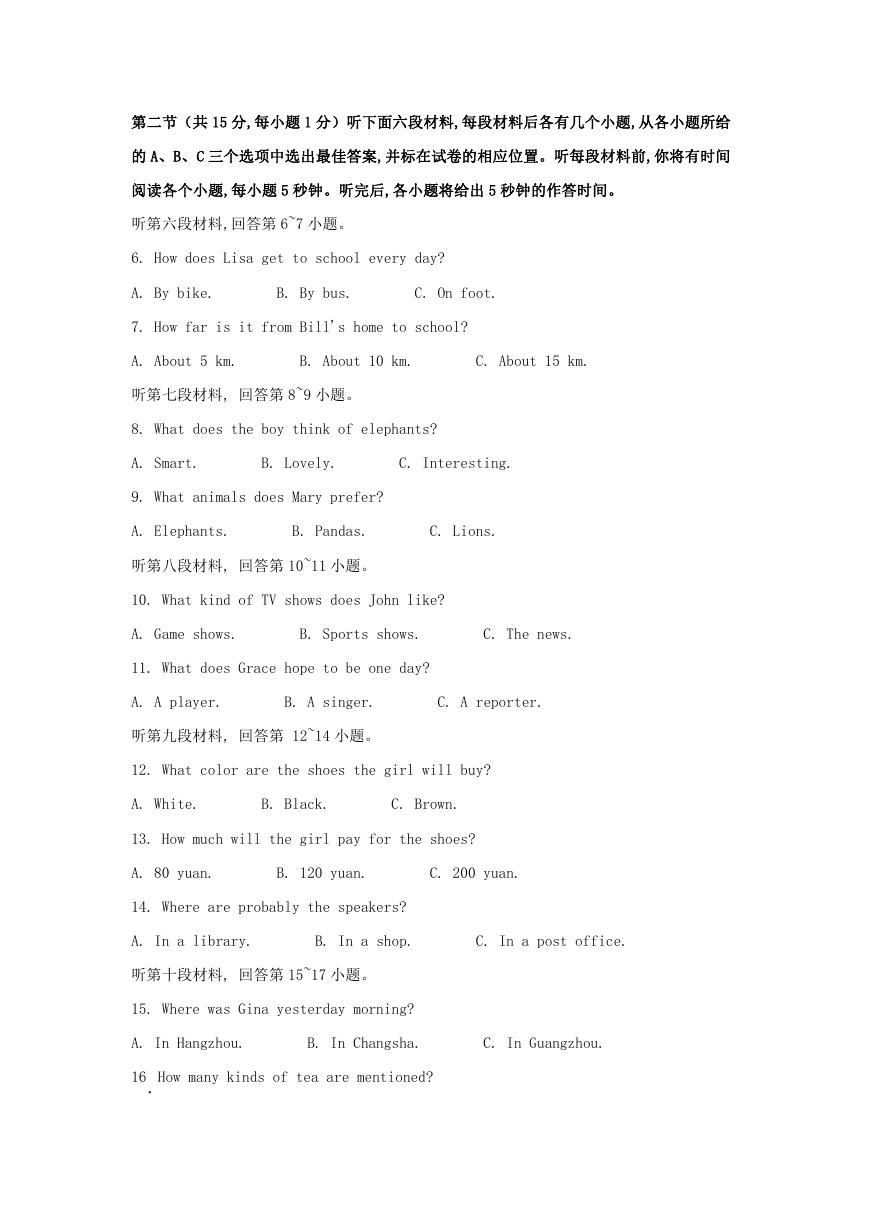
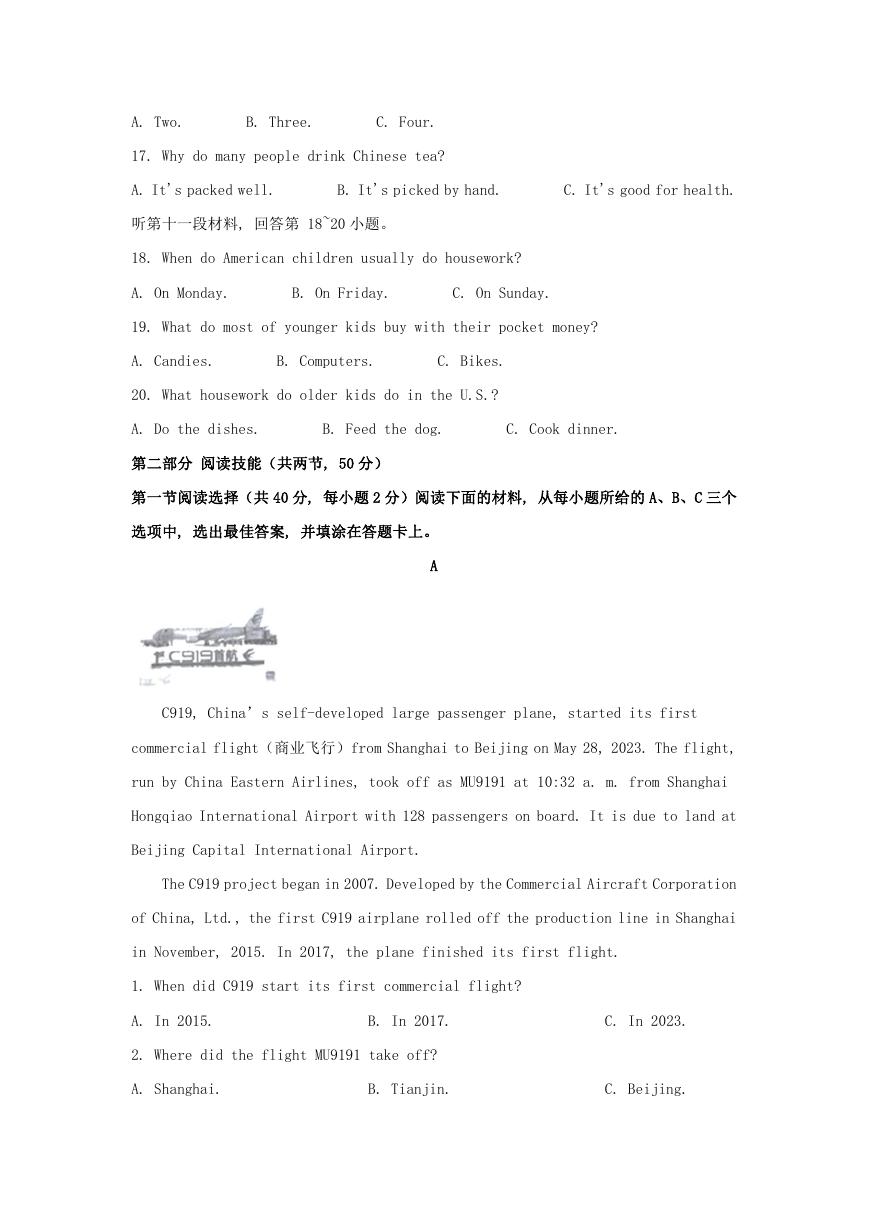
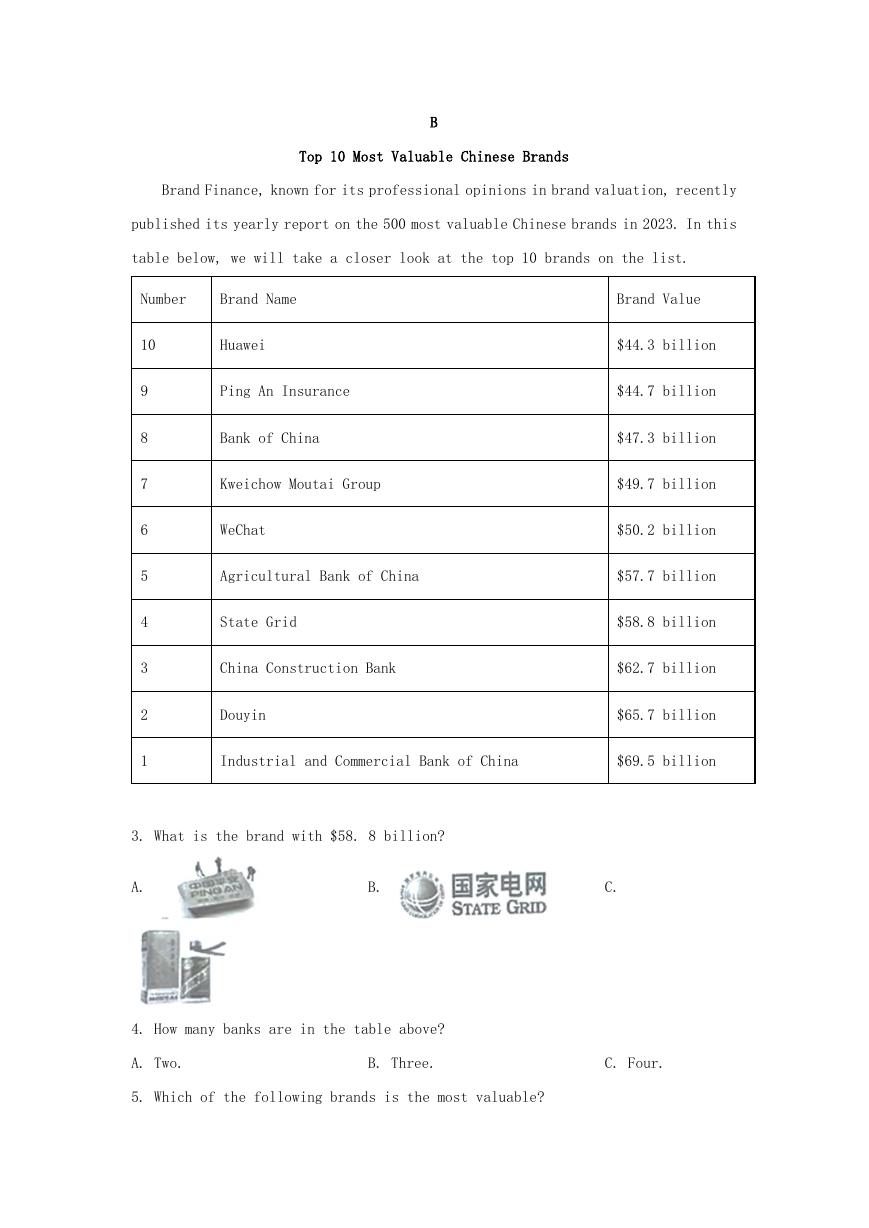

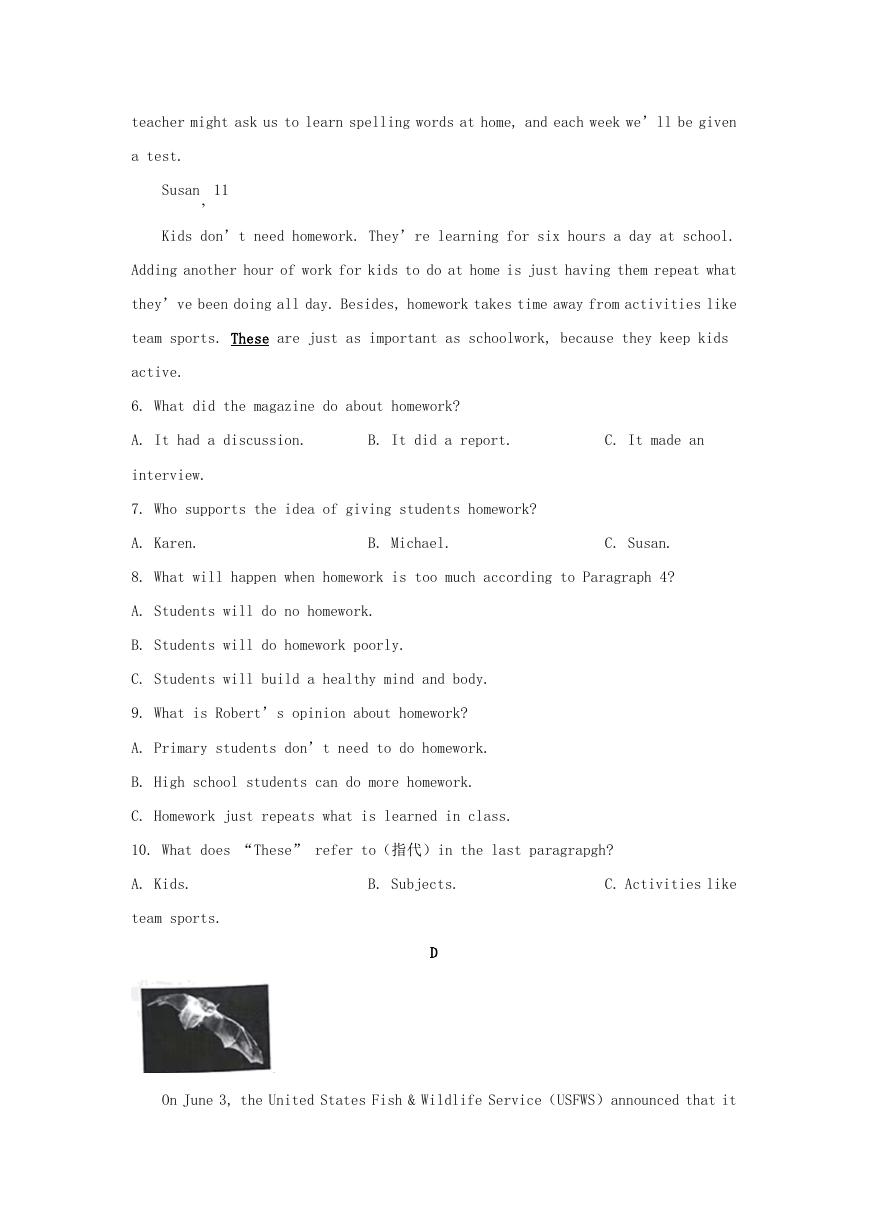
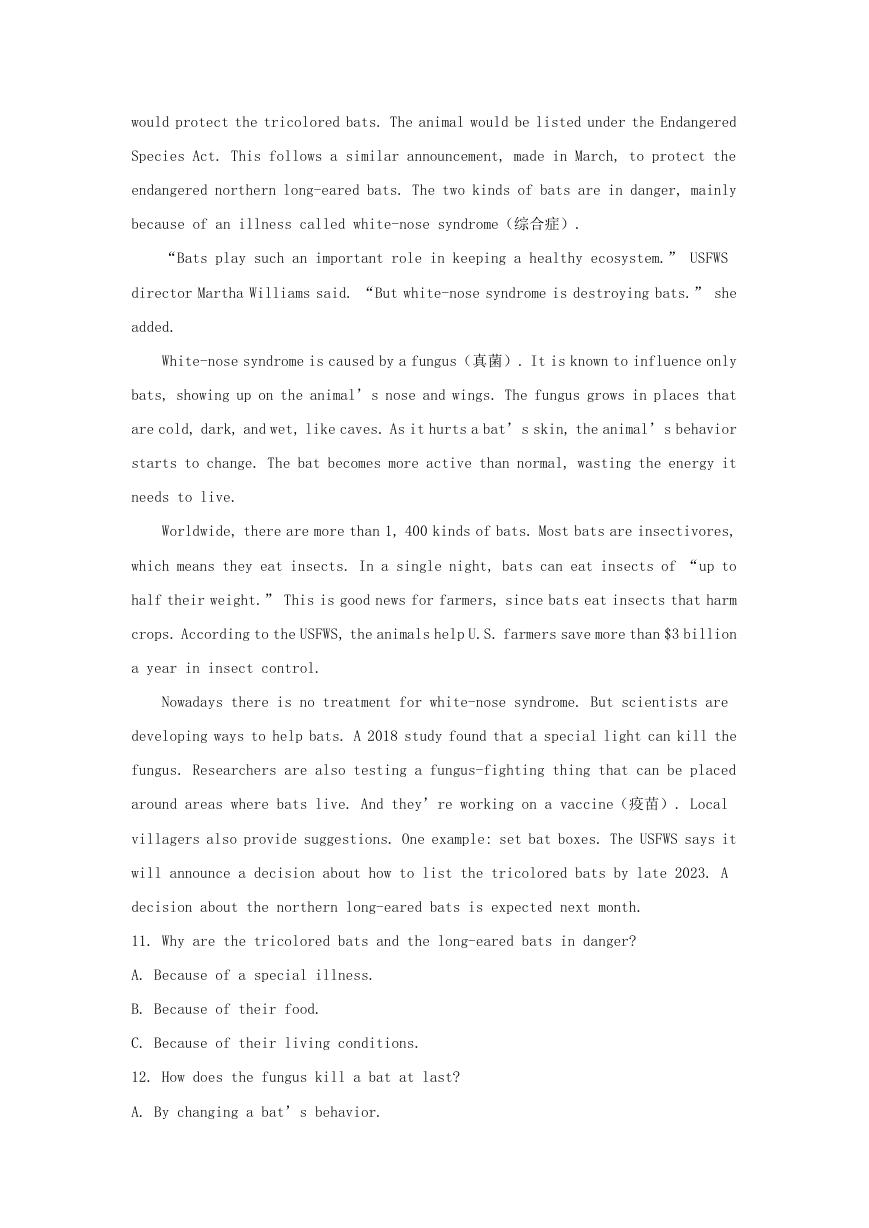
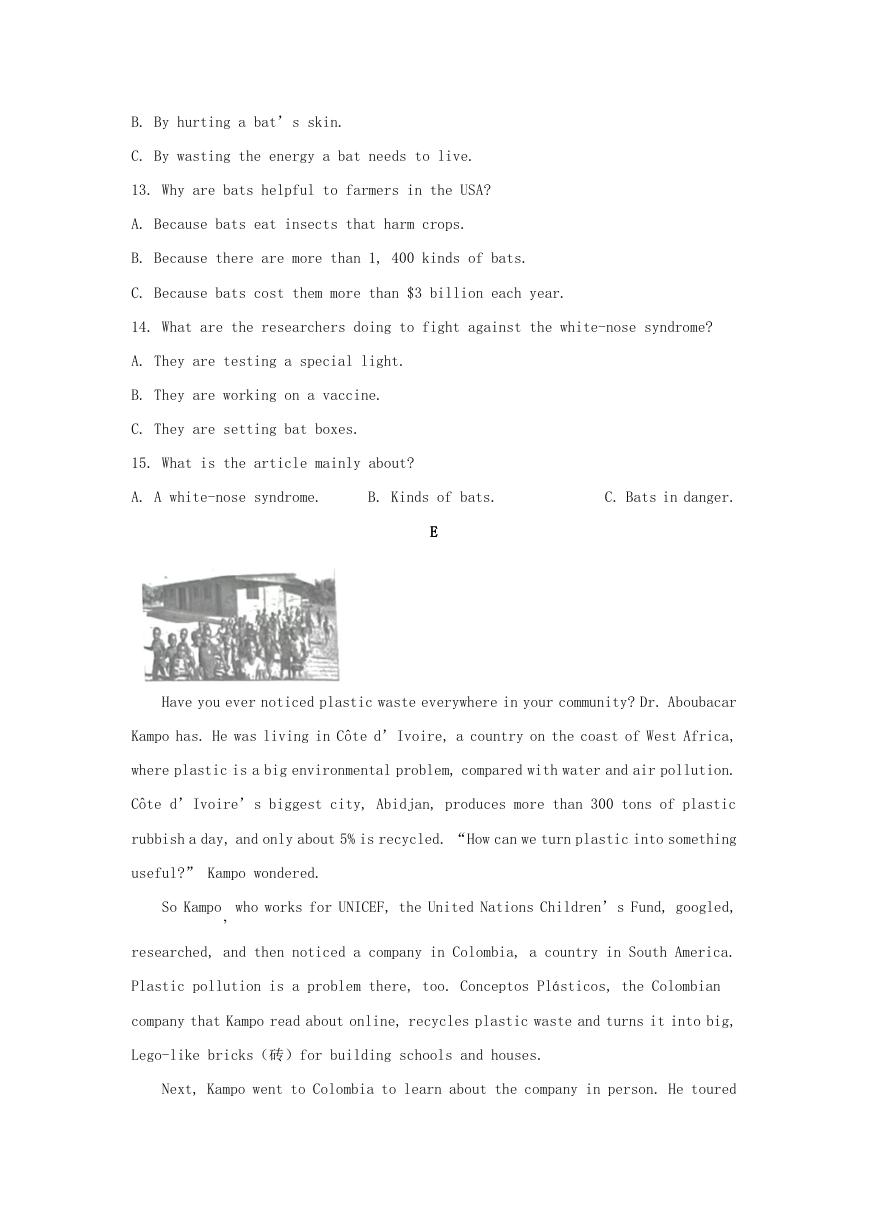








 2023年江西萍乡中考道德与法治真题及答案.doc
2023年江西萍乡中考道德与法治真题及答案.doc 2012年重庆南川中考生物真题及答案.doc
2012年重庆南川中考生物真题及答案.doc 2013年江西师范大学地理学综合及文艺理论基础考研真题.doc
2013年江西师范大学地理学综合及文艺理论基础考研真题.doc 2020年四川甘孜小升初语文真题及答案I卷.doc
2020年四川甘孜小升初语文真题及答案I卷.doc 2020年注册岩土工程师专业基础考试真题及答案.doc
2020年注册岩土工程师专业基础考试真题及答案.doc 2023-2024学年福建省厦门市九年级上学期数学月考试题及答案.doc
2023-2024学年福建省厦门市九年级上学期数学月考试题及答案.doc 2021-2022学年辽宁省沈阳市大东区九年级上学期语文期末试题及答案.doc
2021-2022学年辽宁省沈阳市大东区九年级上学期语文期末试题及答案.doc 2022-2023学年北京东城区初三第一学期物理期末试卷及答案.doc
2022-2023学年北京东城区初三第一学期物理期末试卷及答案.doc 2018上半年江西教师资格初中地理学科知识与教学能力真题及答案.doc
2018上半年江西教师资格初中地理学科知识与教学能力真题及答案.doc 2012年河北国家公务员申论考试真题及答案-省级.doc
2012年河北国家公务员申论考试真题及答案-省级.doc 2020-2021学年江苏省扬州市江都区邵樊片九年级上学期数学第一次质量检测试题及答案.doc
2020-2021学年江苏省扬州市江都区邵樊片九年级上学期数学第一次质量检测试题及答案.doc 2022下半年黑龙江教师资格证中学综合素质真题及答案.doc
2022下半年黑龙江教师资格证中学综合素质真题及答案.doc